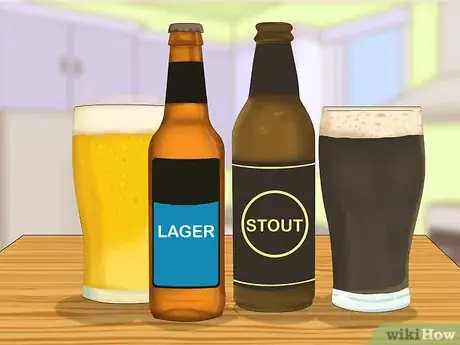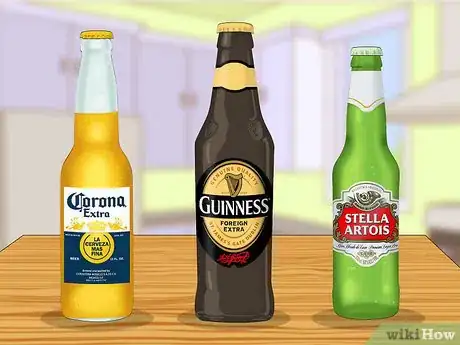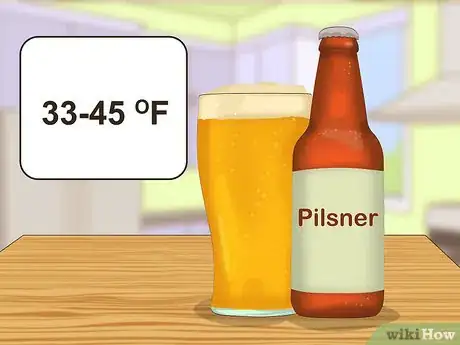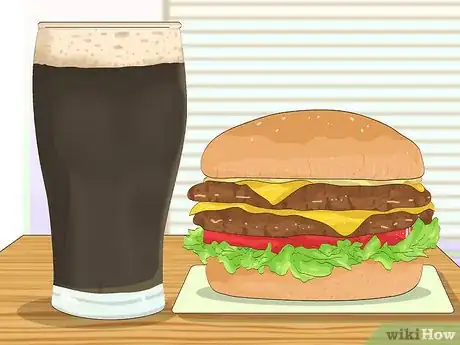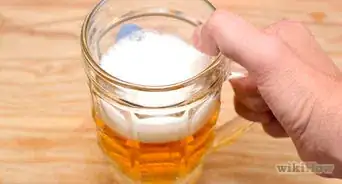This article was co-authored by Tom Blake. Tom Blake manages the bartending blog, craftybartending.com. He has been a bartender since 2012 and has written a book named The Bartender's Field Manual.
There are 17 references cited in this article, which can be found at the bottom of the page.
This article has been viewed 929,959 times.
If you've tried beer in the past and didn't enjoy it, that doesn't necessarily mean you're not a beer person. You may just need to acquire a taste for it. Fortunately, you can learn to enjoy the taste of beer while having fun trying different kinds along the way!
Steps
Finding a Beer You Like
-
1Drink different kinds of beer. When most people believe they don’t like beer, it’s because they’ve only had the bad stuff. Be sure to give other types a beer a chance, from high-end artisanal microbrews to more common brands like Coors and Budweiser. As with anything else, it may be that there’s another sort of beer out there that you’d like better.
- Don’t be afraid to try out beers that you’ve never had before.
- Start ordering one or two new beers anytime you visit a bar or go out to eat.
-
2Switch to a different strength. If you find one beer to be overpowering, transition to a lighter style. These tend to be less fermented, which means they won’t be quite as bitter. On the flipside, people who are dissatisfied with weak, watery beers can try brews with more intense flavors, like porters and stouts.[1]
- Stout beers contain more pungent hops and are allowed to ferment longer, giving them more of a kick.
- Light beers are considerably more delicate. They make a great introduction for people who are just beginning to develop a taste for beer.
Advertisement -
3Sample the range of brewing styles. Beers are classified by their brewing styles, the amount of time they're allowed to ferment and the ingredients used to give them their distinctive flavors.[2] The more styles of beer you try, the more likely you are to find one that's pleasing to you.
- Try lagers, which are cool and refreshing ales, which go down smoothly and have a mild nutty or spicy aftertaste.
- Go for a sweet malt beer that boasts notes of rich caramel and toffee.
- When it's hot out, try Saisons, highly carbonated pale ales brewed with fruit, which makes them light and crisp.
- Lambics ferment with wild yeast and are often sour and cidery.
- Dark beers like porters and stouts are full-bodied and have a strong, bitter flavor, not unlike coffee.
-
4Give craft beers a shot. It isn’t just the big, well-known companies making beer. There is a myriad of microbreweries churning out small batches of beer using their own proprietary recipes. One of these beers may be better suited for your taste buds.[3]
- Look for specialty craft beers on tap at trendy bars, or take a tour of the alcoholic beverage section at your local supermarket.
- If you live in a city that’s home to a craft beer company, visit the brewery and try samples of some of their most celebrated concoctions.[4]
-
5Try beers from other countries. In addition to what’s known as “domestic” beers, there are countless foreign varieties readily available from places all over the globe. You can find beers from Europe, Asia, South America and even Australia with little difficulty. These beers often use different ingredients or brewing techniques which can result in wildly unique flavors.[5]
- Some examples of popular beers worldwide include Guinness (Ireland), Corona (Mexico), Heineken (Netherlands), Sapporo (Japan), Ayinger (Germany) and Stella Artois (Belgium).
- Most of the better-known foreign beers are imported around the world and kept stocked in bars, restaurants, and supermarkets.
Developing a Taste for Beer
-
1Learn to detect complex flavors. There’s a lot to take in with a single sip of beer. Rather than immediately coming to a decision about whether or not you like a particular style, try to pick up on the small nuances the beer possesses. Is the bitterness properly offset by sweetness or acidity? Are there subtle nutty or floral notes? Relating the overall taste of the beer to individual flavors that you do like can help you get more out of it.[6]
- Take a couple whiffs of the beer and swish it around in your mouth for a few seconds before swallowing.[7]
- As you taste the beer, try to get past the initial bitterness and see what sorts of flavor profiles come to mind.
-
2Drink beer at the correct temperature. Not all beers are meant to be savored at the same temperature. If the beer you’re drinking is too warm or too cold, it can cause the flavor to become overly sharp, bland or generally unpleasant. Heed the suggestions of the brewmaster provided on the label or ask your bartender for advice on how best to enjoy a certain type of beer.[8]
- Lighter beers like lagers, blondes, and pilsners be should served at around 33–45 °F (1–7 °C), while stouts, porters and strong, dark beers are best when sipped at room temperature.[9]
- Avoid drinking beer from a frosted mug. It can cause the beer to freeze where it comes into contact with the glass, spoiling the flavor.[10]
- Chill beer, don’t add ice to it. A watered down brew will not have the same potency or body.
-
3Use the right drinking container. The material a beer is stored in can influence its flavor just as much as its brewing methods. Sometimes the distinctions are minute—you might, for instance, prefer the same beer in a bottle as opposed to a can. Similarly, draft beers served in a glass may have a fresher taste than bottled beers. Test each serving style to see which you like best.[11]
- A mug, stein, or can is fine for the majority of beers. Tall pilsner glasses should be used for especially frothy beers, as they help contain the foam and let the diverse flavors bubble to the surface from underneath.[12]
- Brown glass filters out light that can cause beer to sour more quickly, so choose it over clear and green bottles whenever you can.[13]
- Whenever you start on a beer, finish the whole thing or dispose of what you don’t drink. Beer spoils quickly after it’s opened and is usually no good leftover.
-
4Give it time. People’s tastes change as they get older. It may be that your palette just isn’t equipped to enjoy beer at this point in your life, but that doesn’t mean it never will. Continue trying different beers here and there, and, above all, keep an open mind. Chances are, you’ll eventually encounter one that does it for you.[14]
- The next time someone offers you a beer, don’t turn up your nose. If you renounce beer entirely, you’ll never get the chance to discover for yourself what so many people love about it.
- Many people find beer to be bitter the first time they try it, which can be off-putting. However, over time, you may notice other flavors that you find enjoyable.
Making Beer Drinking More Enjoyable
-
1Pair your beer with food. Even if you’re not a fan of drinking beer by itself, what you’re eating with it can make all the difference. You may find that a Saison is surprisingly crisp and refreshing when sipped alongside a platter of broiled seafood, or that a dark, bitter stout makes the perfect companion for a juicy cheeseburger. When mingled with the flavors of a meal, a beer’s body can transform and take on new complexity.[15]
- Like wine, different beers are typically recommended for pairing with different foods.[16]
- With time, you’ll develop a sense of which flavor combinations you find appetizing together.
-
2Drink beer in a comfortable setting. Atmosphere can also play a big part in how much enjoyment you get from beer. You probably won’t get the same satisfaction from splitting a pitcher in a crowded, deafening dive bar as you would sharing with a tall one with your best friends from the comfort of your own home. If you’re not big on your surroundings, that distaste may rub off on you when it comes time to drain a pint.[17]
- Stay away from places with strong smells or other unwanted distractions that might detract from your experience.
- Set up a tasting at your home with a friend who’s a connoisseur. They’ll be able to make recommendations and give you cues on how to savor your beer.
-
3Change your perception of beer. You’re never going to appreciate beer if you convince yourself that you don’t like it. Make an effort to stop thinking of all beers in black and white terms. Once you soften your stance, you’ll be able to start judging each unique form of the beverage on its own merits.
- If you don’t like one style, move on to the next until something stands out to you.
- Try not to overthink it. It’s just a drink.
Expert Q&A
Did you know you can get expert answers for this article?
Unlock expert answers by supporting wikiHow
-
QuestionWhat if I'm not old enough?
 Tom BlakeTom Blake manages the bartending blog, craftybartending.com. He has been a bartender since 2012 and has written a book named The Bartender's Field Manual.
Tom BlakeTom Blake manages the bartending blog, craftybartending.com. He has been a bartender since 2012 and has written a book named The Bartender's Field Manual.
Professional Bartender
-
QuestionI usually don't like beer but I occasionally enjoy a Guinness. What other brands might you suggest?
 Community AnswerGuinness is a bold, dark stout, so if you like it you'll probably also enjoy other Irish stouts like Murphy's, Imperial or Kilkenny cream ale.
Community AnswerGuinness is a bold, dark stout, so if you like it you'll probably also enjoy other Irish stouts like Murphy's, Imperial or Kilkenny cream ale. -
QuestionI am a big fan of Corona. but I want a change. Any suggestions?
 Community AnswerTry either Modelo or Michelobe.
Community AnswerTry either Modelo or Michelobe.
Warnings
- You should never attempt to drive after drinking. Call a cab or have a friend give you a ride home.⧼thumbs_response⧽
- Alcoholic beverages like beer should only be enjoyed by responsible adults of legal drinking age.⧼thumbs_response⧽
- While sampling various beers, be careful not to drink so much that you become intoxicated.⧼thumbs_response⧽
References
- ↑ http://www.thebeerstore.ca/beer-101/beer-types
- ↑ https://www.craftbeer.com/beer/beer-styles-guide
- ↑ https://learn.kegerator.com/drink-craft-beer/
- ↑ http://www.endlesssimmer.com/2012/06/15/top-10-reasons-to-drink-craft-beer/
- ↑ http://vinepair.com/wine-blog/20-most-popular-imported-beers-in-america/
- ↑ http://www.chicagotribune.com/redeye/redeye-beer-guide-for-people-who-dont-like-beer-20160229-story.html
- ↑ http://beerology.ca/how-to-taste-beer/
- ↑ http://craftbeertemple.com/videoblog/serving-beer/
- ↑ https://www.homebrewersassociation.org/how-to-brew/proper-beer-serving-temperatures/
- ↑ https://www.thrillist.com/drink/nation/the-5-biggest-mistakes-you-re-making-with-your-beer
- ↑ https://www.thrillist.com/drink/nation/beer-cans-vs-bottles-which-is-better
- ↑ https://learn.kegerator.com/beer-glasses/
- ↑ http://www.mensfitness.com/nutrition/what-to-drink/ask-mens-fitness-does-container-actually-affect-beer-taste
- ↑ http://www.bonappetit.com/entertaining-style/trends-news/article/sense-of-taste-changes-aging
- ↑ http://www.epicurious.com/archive/drinking/beer/beerpairings
- ↑ https://www.craftbeer.com/tasting-tools/beer-food-chart
- ↑ http://redrockbrewing.com/9-tips-for-getting-the-most-out-of-your-beer
About This Article
To like the taste of beer more, opt for lighter beers, like lagers or pilsners, instead of heavier beers, like stouts or IPAs, since they'll be less overpowering. You can also try pairing beer with some food, like a cheeseburger or seafood, since the flavors from the food will enhance the taste of the beer. Additionally, when you're drinking beer, make sure it's chilled, and avoid pouring it on ice since ice can water down beer and make it taste bad. For more advice from our Bartender co-author, like how to choose the right drinking glasses for beer, read on!


